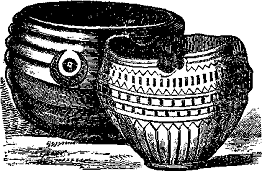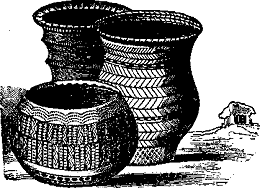Ancient Irish Sepulchral Urns
[From the Dublin Penny Journal, Vol. 1, No. 14, September 29, 1832]
The custom of burning the dead and depositing the ashes in urns, appears to have been general in every part of Europe, and perhaps Asia, in the most remote times. Cinerary urns of this kind are found daily in Ireland, which abounds with sepulchral monuments of Pagan times, to an extent greater than any other country of Europe— and the Cairns or Tumuli of the Irish are only excelled in grandeur of size and magnificence of construction by those of the ancient Greeks.
Sir Richard Colt Hoare, the greatest antiquarian explorer of the English barrows, is obliged to confess that the sepulchral urns of Ireland are superior in ornament to any found in England, and that the ornaments of gold frequently found in them, are richer and more numerous. He endeavours to account for this extraordinary circumstance by supposing Ireland to have been peopled by Gallic tribes, who poured into it at a later, and consequently more civilized period, than that at which they colonized Britain. But be this as it may—and we do not concur in his reasoning—the fact is acknowledged, that the Pagan Irish were superior in the arts of civilized life to their British neighbours.
In some future number we shall treat this curious subject at some length, and, in the mean time, we present our readers with representations of a few varieties of our ancient sepulchral urns, as illustrations of our little history of the progress of the arts in Ireland.

Of the urns represented in the above cut, the smaller was found with five others near Powerscourt, in the county of Wicklow, about a century ago, and has been published in Harris's edition of Ware's works. It was, as usual, composed of baked clay. The larger urn, which was of stone, was found at Knowth, the estate of the Nettervilles, in the county of Meath, and was extremely remarkable both on account of its material, and of its having sculptured on its opposite sides, representations of the two great deities of the pagan Irish—the Sun and Moon. This urn also has been published: it appears in the essay on Danish Mounts, &c., by Dr. Molyneaux, who vainly endeavours to prove that it must have belonged to that ancient people.

The urns represented in the next group were found with nine others in a cairn at Mount-Stewart, near Grey-Abbey, in the county of Down. They have not been hitherto published, and do not, we fear, now exist. We are informed that they were deposited in a garden-house of the Marquess Londonderry, and destroyed for want of care.
The cairn in which these urns were discovered, was one of the most remarkable in Ireland for the number of its interments, in which particular it resembled the celebrated Deveril barrow in Dorsetshire, which has been thought worthy of an elegant descriptive work, (London, 1826.) The urns in the English barrow were more numerous than in the Irish one, but they were greatly inferior in ornament and workmanship. In both the urns all presented a variety of forms and decorations.
In our next we will give an account of the Irish cairn, extracted from the account furnished to General Vallancey by that truly eminent naturalist, the late Mr. Templeton of Belfast.
